Analysis of Reimbursement Methods for Physicians in Saudi Arabia
VerifiedAdded on 2022/10/15
|8
|2154
|404
Essay
AI Summary
This essay explores the different types of reimbursement methods for physicians in Saudi Arabia and their impact on healthcare facilities. It delves into bundled payments, fee-for-service (FFS), and pay-for-performance (P4P) models, analyzing their advantages and disadvantages. The essay highlights the role of organizations like the Central Board for the Accreditation of Health Institutions (CBAHI) and the Council of Cooperative Health Insurance (CCHI) in regulating healthcare and physician compensation. It argues that bundled payment is the highest quality reimbursement method, as it incentivizes coordinated care and cost-effectiveness, leading to improved patient outcomes and reduced healthcare expenditure. The essay also discusses how reimbursement systems influence physician behavior and impact access, utilization, and the quality of primary care, ultimately concluding that reimbursement plays a crucial role in shaping the healthcare landscape in Saudi Arabia. The essay uses several research papers to support its claims.

Running head: ESSAY
Reimbursement methods for healthcare for physicians in Saudi Arabia
Name of the Student
Name of the University
Author Note
Reimbursement methods for healthcare for physicians in Saudi Arabia
Name of the Student
Name of the University
Author Note
Paraphrase This Document
Need a fresh take? Get an instant paraphrase of this document with our AI Paraphraser
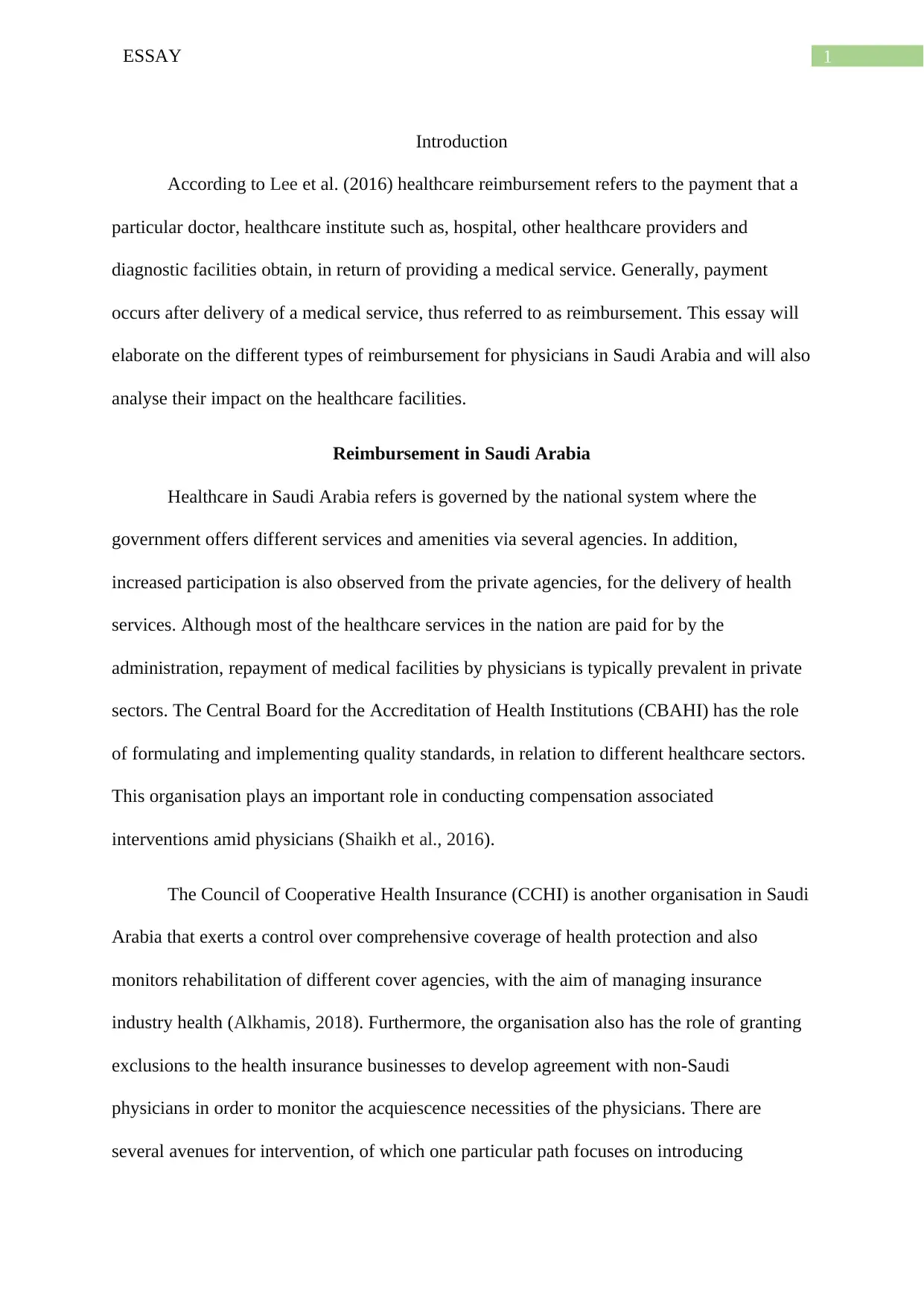
1ESSAY
Introduction
According to Lee et al. (2016) healthcare reimbursement refers to the payment that a
particular doctor, healthcare institute such as, hospital, other healthcare providers and
diagnostic facilities obtain, in return of providing a medical service. Generally, payment
occurs after delivery of a medical service, thus referred to as reimbursement. This essay will
elaborate on the different types of reimbursement for physicians in Saudi Arabia and will also
analyse their impact on the healthcare facilities.
Reimbursement in Saudi Arabia
Healthcare in Saudi Arabia refers is governed by the national system where the
government offers different services and amenities via several agencies. In addition,
increased participation is also observed from the private agencies, for the delivery of health
services. Although most of the healthcare services in the nation are paid for by the
administration, repayment of medical facilities by physicians is typically prevalent in private
sectors. The Central Board for the Accreditation of Health Institutions (CBAHI) has the role
of formulating and implementing quality standards, in relation to different healthcare sectors.
This organisation plays an important role in conducting compensation associated
interventions amid physicians (Shaikh et al., 2016).
The Council of Cooperative Health Insurance (CCHI) is another organisation in Saudi
Arabia that exerts a control over comprehensive coverage of health protection and also
monitors rehabilitation of different cover agencies, with the aim of managing insurance
industry health (Alkhamis, 2018). Furthermore, the organisation also has the role of granting
exclusions to the health insurance businesses to develop agreement with non-Saudi
physicians in order to monitor the acquiescence necessities of the physicians. There are
several avenues for intervention, of which one particular path focuses on introducing
Introduction
According to Lee et al. (2016) healthcare reimbursement refers to the payment that a
particular doctor, healthcare institute such as, hospital, other healthcare providers and
diagnostic facilities obtain, in return of providing a medical service. Generally, payment
occurs after delivery of a medical service, thus referred to as reimbursement. This essay will
elaborate on the different types of reimbursement for physicians in Saudi Arabia and will also
analyse their impact on the healthcare facilities.
Reimbursement in Saudi Arabia
Healthcare in Saudi Arabia refers is governed by the national system where the
government offers different services and amenities via several agencies. In addition,
increased participation is also observed from the private agencies, for the delivery of health
services. Although most of the healthcare services in the nation are paid for by the
administration, repayment of medical facilities by physicians is typically prevalent in private
sectors. The Central Board for the Accreditation of Health Institutions (CBAHI) has the role
of formulating and implementing quality standards, in relation to different healthcare sectors.
This organisation plays an important role in conducting compensation associated
interventions amid physicians (Shaikh et al., 2016).
The Council of Cooperative Health Insurance (CCHI) is another organisation in Saudi
Arabia that exerts a control over comprehensive coverage of health protection and also
monitors rehabilitation of different cover agencies, with the aim of managing insurance
industry health (Alkhamis, 2018). Furthermore, the organisation also has the role of granting
exclusions to the health insurance businesses to develop agreement with non-Saudi
physicians in order to monitor the acquiescence necessities of the physicians. There are
several avenues for intervention, of which one particular path focuses on introducing
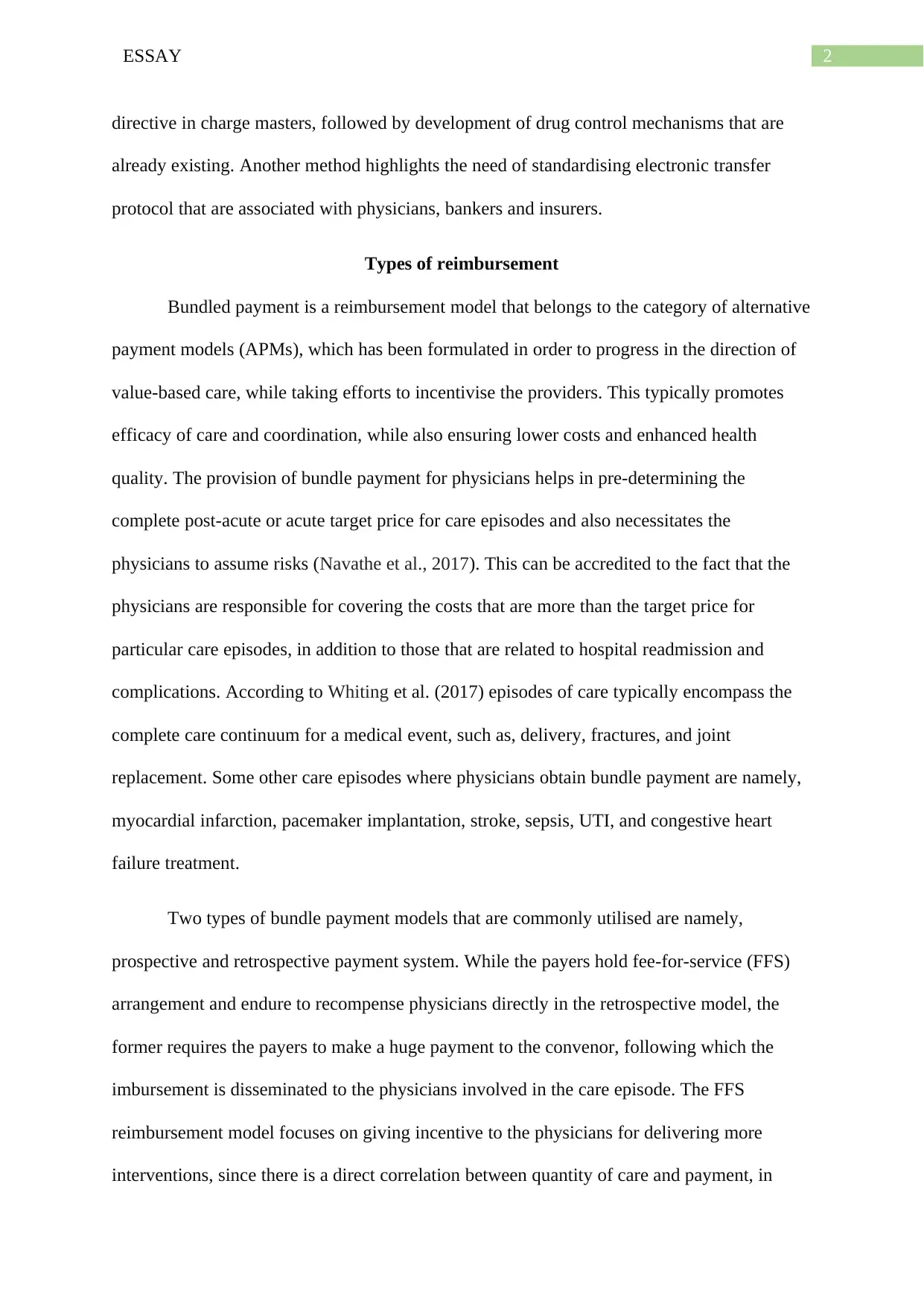
2ESSAY
directive in charge masters, followed by development of drug control mechanisms that are
already existing. Another method highlights the need of standardising electronic transfer
protocol that are associated with physicians, bankers and insurers.
Types of reimbursement
Bundled payment is a reimbursement model that belongs to the category of alternative
payment models (APMs), which has been formulated in order to progress in the direction of
value-based care, while taking efforts to incentivise the providers. This typically promotes
efficacy of care and coordination, while also ensuring lower costs and enhanced health
quality. The provision of bundle payment for physicians helps in pre-determining the
complete post-acute or acute target price for care episodes and also necessitates the
physicians to assume risks (Navathe et al., 2017). This can be accredited to the fact that the
physicians are responsible for covering the costs that are more than the target price for
particular care episodes, in addition to those that are related to hospital readmission and
complications. According to Whiting et al. (2017) episodes of care typically encompass the
complete care continuum for a medical event, such as, delivery, fractures, and joint
replacement. Some other care episodes where physicians obtain bundle payment are namely,
myocardial infarction, pacemaker implantation, stroke, sepsis, UTI, and congestive heart
failure treatment.
Two types of bundle payment models that are commonly utilised are namely,
prospective and retrospective payment system. While the payers hold fee-for-service (FFS)
arrangement and endure to recompense physicians directly in the retrospective model, the
former requires the payers to make a huge payment to the convenor, following which the
imbursement is disseminated to the physicians involved in the care episode. The FFS
reimbursement model focuses on giving incentive to the physicians for delivering more
interventions, since there is a direct correlation between quantity of care and payment, in
directive in charge masters, followed by development of drug control mechanisms that are
already existing. Another method highlights the need of standardising electronic transfer
protocol that are associated with physicians, bankers and insurers.
Types of reimbursement
Bundled payment is a reimbursement model that belongs to the category of alternative
payment models (APMs), which has been formulated in order to progress in the direction of
value-based care, while taking efforts to incentivise the providers. This typically promotes
efficacy of care and coordination, while also ensuring lower costs and enhanced health
quality. The provision of bundle payment for physicians helps in pre-determining the
complete post-acute or acute target price for care episodes and also necessitates the
physicians to assume risks (Navathe et al., 2017). This can be accredited to the fact that the
physicians are responsible for covering the costs that are more than the target price for
particular care episodes, in addition to those that are related to hospital readmission and
complications. According to Whiting et al. (2017) episodes of care typically encompass the
complete care continuum for a medical event, such as, delivery, fractures, and joint
replacement. Some other care episodes where physicians obtain bundle payment are namely,
myocardial infarction, pacemaker implantation, stroke, sepsis, UTI, and congestive heart
failure treatment.
Two types of bundle payment models that are commonly utilised are namely,
prospective and retrospective payment system. While the payers hold fee-for-service (FFS)
arrangement and endure to recompense physicians directly in the retrospective model, the
former requires the payers to make a huge payment to the convenor, following which the
imbursement is disseminated to the physicians involved in the care episode. The FFS
reimbursement model focuses on giving incentive to the physicians for delivering more
interventions, since there is a direct correlation between quantity of care and payment, in
⊘ This is a preview!⊘
Do you want full access?
Subscribe today to unlock all pages.

Trusted by 1+ million students worldwide
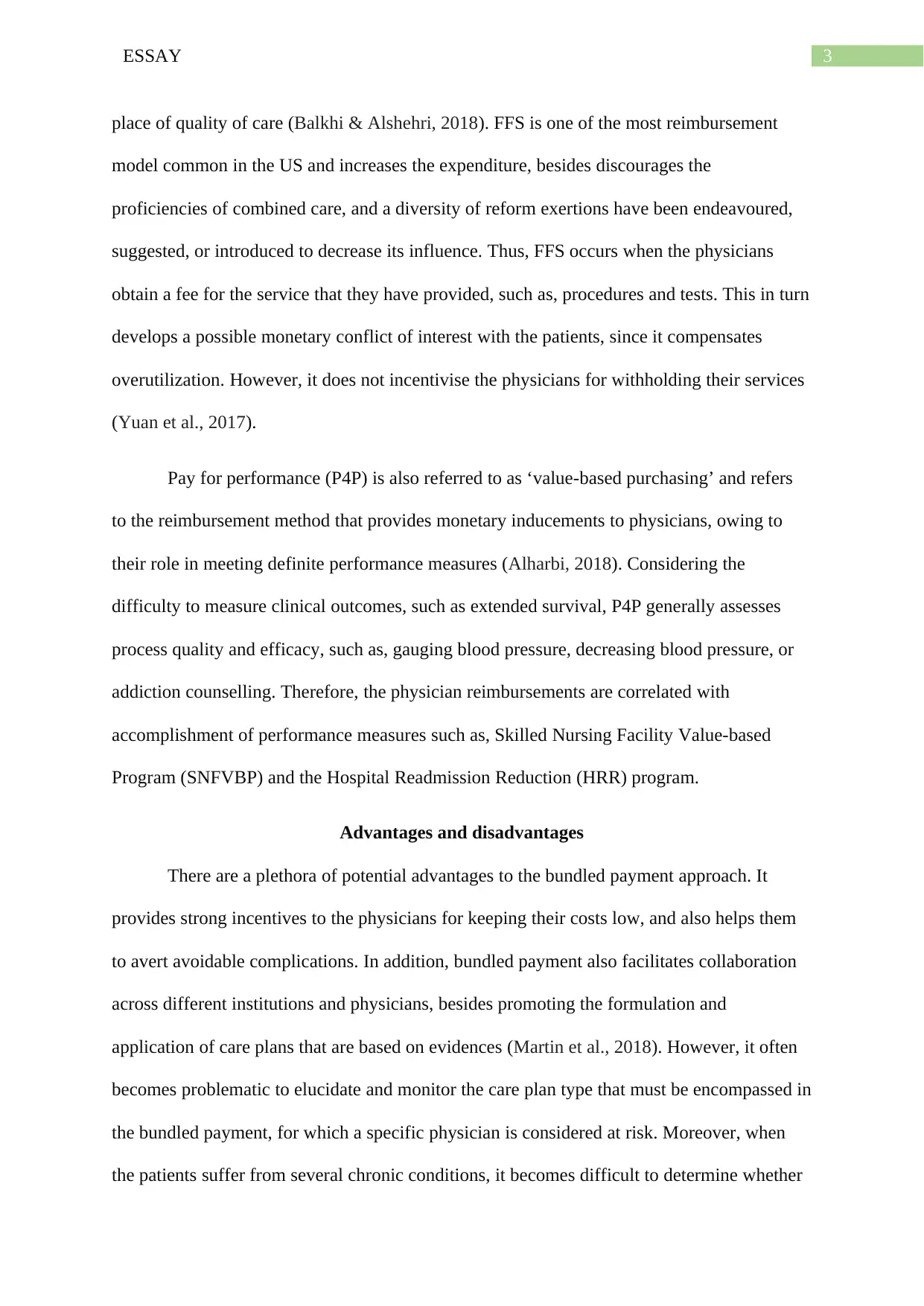
3ESSAY
place of quality of care (Balkhi & Alshehri, 2018). FFS is one of the most reimbursement
model common in the US and increases the expenditure, besides discourages the
proficiencies of combined care, and a diversity of reform exertions have been endeavoured,
suggested, or introduced to decrease its influence. Thus, FFS occurs when the physicians
obtain a fee for the service that they have provided, such as, procedures and tests. This in turn
develops a possible monetary conflict of interest with the patients, since it compensates
overutilization. However, it does not incentivise the physicians for withholding their services
(Yuan et al., 2017).
Pay for performance (P4P) is also referred to as ‘value-based purchasing’ and refers
to the reimbursement method that provides monetary inducements to physicians, owing to
their role in meeting definite performance measures (Alharbi, 2018). Considering the
difficulty to measure clinical outcomes, such as extended survival, P4P generally assesses
process quality and efficacy, such as, gauging blood pressure, decreasing blood pressure, or
addiction counselling. Therefore, the physician reimbursements are correlated with
accomplishment of performance measures such as, Skilled Nursing Facility Value-based
Program (SNFVBP) and the Hospital Readmission Reduction (HRR) program.
Advantages and disadvantages
There are a plethora of potential advantages to the bundled payment approach. It
provides strong incentives to the physicians for keeping their costs low, and also helps them
to avert avoidable complications. In addition, bundled payment also facilitates collaboration
across different institutions and physicians, besides promoting the formulation and
application of care plans that are based on evidences (Martin et al., 2018). However, it often
becomes problematic to elucidate and monitor the care plan type that must be encompassed in
the bundled payment, for which a specific physician is considered at risk. Moreover, when
the patients suffer from several chronic conditions, it becomes difficult to determine whether
place of quality of care (Balkhi & Alshehri, 2018). FFS is one of the most reimbursement
model common in the US and increases the expenditure, besides discourages the
proficiencies of combined care, and a diversity of reform exertions have been endeavoured,
suggested, or introduced to decrease its influence. Thus, FFS occurs when the physicians
obtain a fee for the service that they have provided, such as, procedures and tests. This in turn
develops a possible monetary conflict of interest with the patients, since it compensates
overutilization. However, it does not incentivise the physicians for withholding their services
(Yuan et al., 2017).
Pay for performance (P4P) is also referred to as ‘value-based purchasing’ and refers
to the reimbursement method that provides monetary inducements to physicians, owing to
their role in meeting definite performance measures (Alharbi, 2018). Considering the
difficulty to measure clinical outcomes, such as extended survival, P4P generally assesses
process quality and efficacy, such as, gauging blood pressure, decreasing blood pressure, or
addiction counselling. Therefore, the physician reimbursements are correlated with
accomplishment of performance measures such as, Skilled Nursing Facility Value-based
Program (SNFVBP) and the Hospital Readmission Reduction (HRR) program.
Advantages and disadvantages
There are a plethora of potential advantages to the bundled payment approach. It
provides strong incentives to the physicians for keeping their costs low, and also helps them
to avert avoidable complications. In addition, bundled payment also facilitates collaboration
across different institutions and physicians, besides promoting the formulation and
application of care plans that are based on evidences (Martin et al., 2018). However, it often
becomes problematic to elucidate and monitor the care plan type that must be encompassed in
the bundled payment, for which a specific physician is considered at risk. Moreover, when
the patients suffer from several chronic conditions, it becomes difficult to determine whether
Paraphrase This Document
Need a fresh take? Get an instant paraphrase of this document with our AI Paraphraser
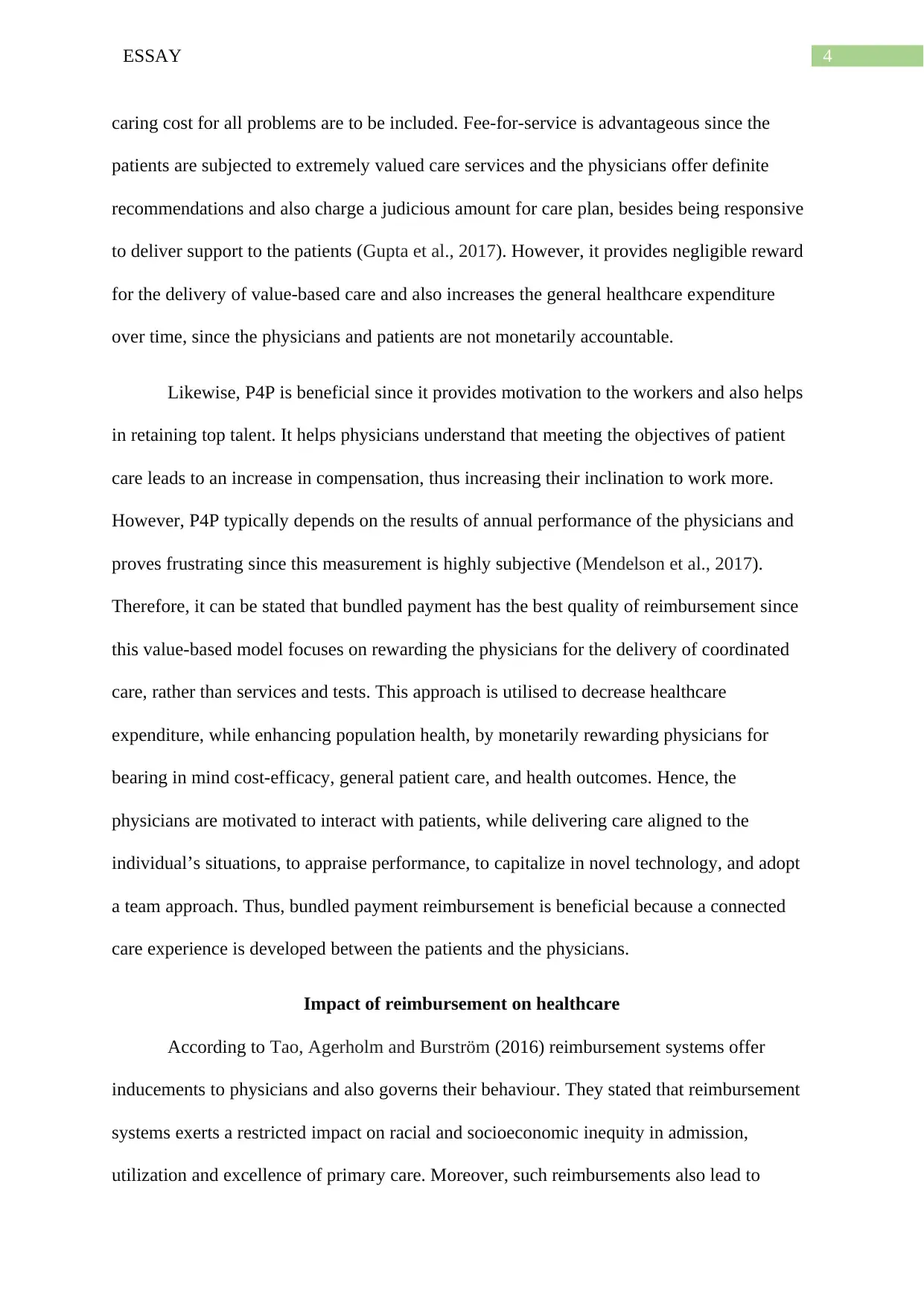
4ESSAY
caring cost for all problems are to be included. Fee-for-service is advantageous since the
patients are subjected to extremely valued care services and the physicians offer definite
recommendations and also charge a judicious amount for care plan, besides being responsive
to deliver support to the patients (Gupta et al., 2017). However, it provides negligible reward
for the delivery of value-based care and also increases the general healthcare expenditure
over time, since the physicians and patients are not monetarily accountable.
Likewise, P4P is beneficial since it provides motivation to the workers and also helps
in retaining top talent. It helps physicians understand that meeting the objectives of patient
care leads to an increase in compensation, thus increasing their inclination to work more.
However, P4P typically depends on the results of annual performance of the physicians and
proves frustrating since this measurement is highly subjective (Mendelson et al., 2017).
Therefore, it can be stated that bundled payment has the best quality of reimbursement since
this value-based model focuses on rewarding the physicians for the delivery of coordinated
care, rather than services and tests. This approach is utilised to decrease healthcare
expenditure, while enhancing population health, by monetarily rewarding physicians for
bearing in mind cost-efficacy, general patient care, and health outcomes. Hence, the
physicians are motivated to interact with patients, while delivering care aligned to the
individual’s situations, to appraise performance, to capitalize in novel technology, and adopt
a team approach. Thus, bundled payment reimbursement is beneficial because a connected
care experience is developed between the patients and the physicians.
Impact of reimbursement on healthcare
According to Tao, Agerholm and Burström (2016) reimbursement systems offer
inducements to physicians and also governs their behaviour. They stated that reimbursement
systems exerts a restricted impact on racial and socioeconomic inequity in admission,
utilization and excellence of primary care. Moreover, such reimbursements also lead to
caring cost for all problems are to be included. Fee-for-service is advantageous since the
patients are subjected to extremely valued care services and the physicians offer definite
recommendations and also charge a judicious amount for care plan, besides being responsive
to deliver support to the patients (Gupta et al., 2017). However, it provides negligible reward
for the delivery of value-based care and also increases the general healthcare expenditure
over time, since the physicians and patients are not monetarily accountable.
Likewise, P4P is beneficial since it provides motivation to the workers and also helps
in retaining top talent. It helps physicians understand that meeting the objectives of patient
care leads to an increase in compensation, thus increasing their inclination to work more.
However, P4P typically depends on the results of annual performance of the physicians and
proves frustrating since this measurement is highly subjective (Mendelson et al., 2017).
Therefore, it can be stated that bundled payment has the best quality of reimbursement since
this value-based model focuses on rewarding the physicians for the delivery of coordinated
care, rather than services and tests. This approach is utilised to decrease healthcare
expenditure, while enhancing population health, by monetarily rewarding physicians for
bearing in mind cost-efficacy, general patient care, and health outcomes. Hence, the
physicians are motivated to interact with patients, while delivering care aligned to the
individual’s situations, to appraise performance, to capitalize in novel technology, and adopt
a team approach. Thus, bundled payment reimbursement is beneficial because a connected
care experience is developed between the patients and the physicians.
Impact of reimbursement on healthcare
According to Tao, Agerholm and Burström (2016) reimbursement systems offer
inducements to physicians and also governs their behaviour. They stated that reimbursement
systems exerts a restricted impact on racial and socioeconomic inequity in admission,
utilization and excellence of primary care. Moreover, such reimbursements also lead to
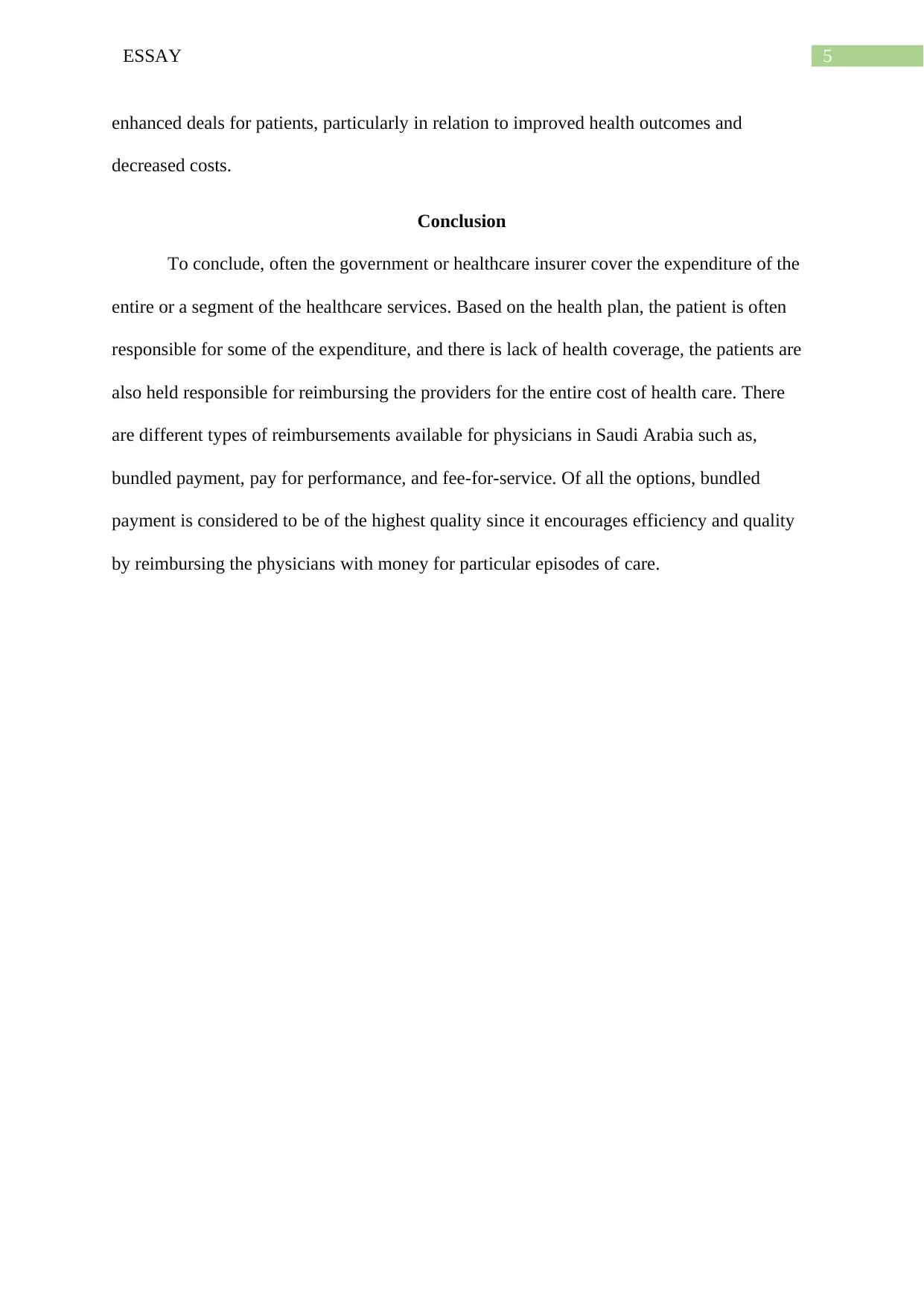
5ESSAY
enhanced deals for patients, particularly in relation to improved health outcomes and
decreased costs.
Conclusion
To conclude, often the government or healthcare insurer cover the expenditure of the
entire or a segment of the healthcare services. Based on the health plan, the patient is often
responsible for some of the expenditure, and there is lack of health coverage, the patients are
also held responsible for reimbursing the providers for the entire cost of health care. There
are different types of reimbursements available for physicians in Saudi Arabia such as,
bundled payment, pay for performance, and fee-for-service. Of all the options, bundled
payment is considered to be of the highest quality since it encourages efficiency and quality
by reimbursing the physicians with money for particular episodes of care.
enhanced deals for patients, particularly in relation to improved health outcomes and
decreased costs.
Conclusion
To conclude, often the government or healthcare insurer cover the expenditure of the
entire or a segment of the healthcare services. Based on the health plan, the patient is often
responsible for some of the expenditure, and there is lack of health coverage, the patients are
also held responsible for reimbursing the providers for the entire cost of health care. There
are different types of reimbursements available for physicians in Saudi Arabia such as,
bundled payment, pay for performance, and fee-for-service. Of all the options, bundled
payment is considered to be of the highest quality since it encourages efficiency and quality
by reimbursing the physicians with money for particular episodes of care.
⊘ This is a preview!⊘
Do you want full access?
Subscribe today to unlock all pages.

Trusted by 1+ million students worldwide
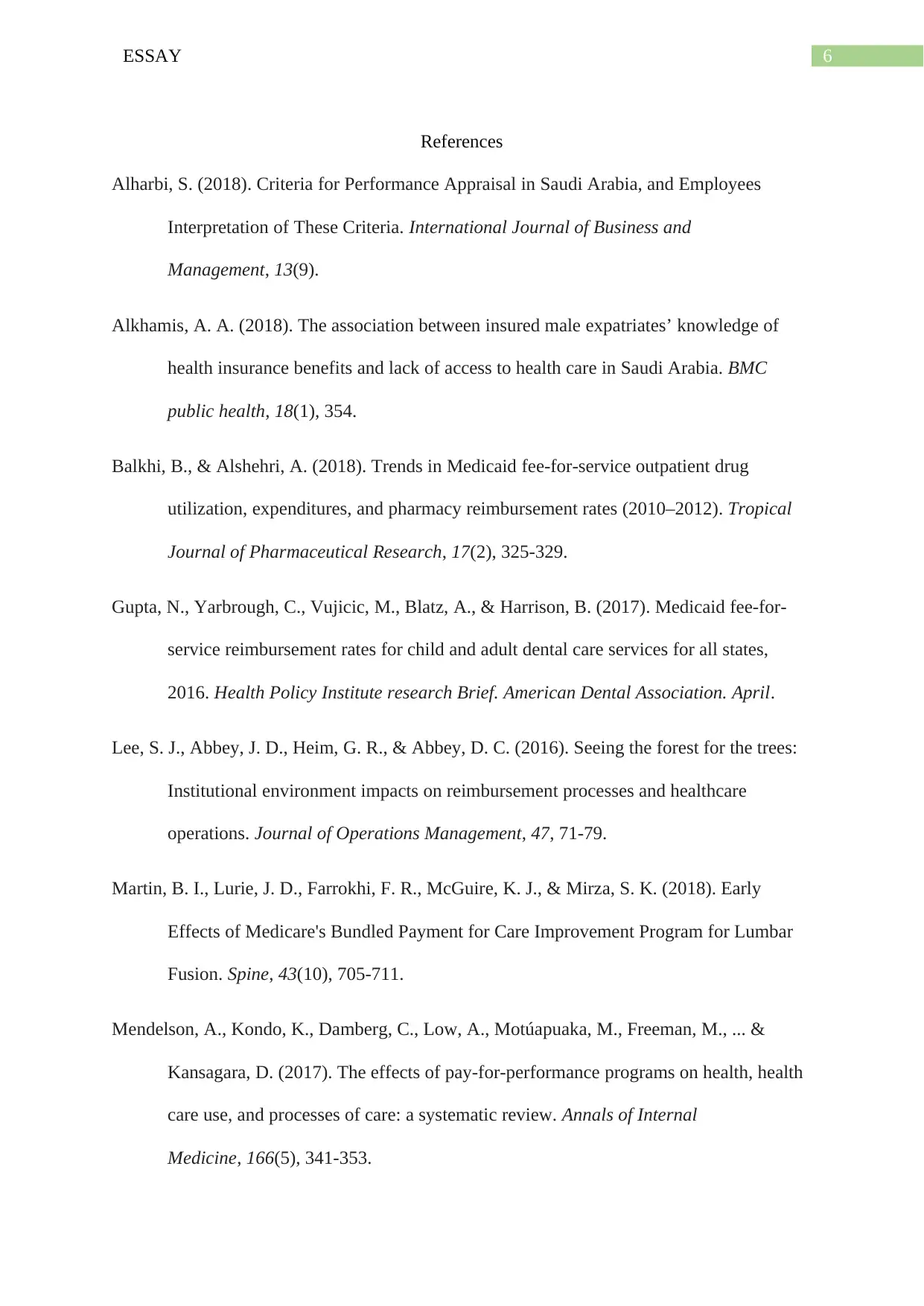
6ESSAY
References
Alharbi, S. (2018). Criteria for Performance Appraisal in Saudi Arabia, and Employees
Interpretation of These Criteria. International Journal of Business and
Management, 13(9).
Alkhamis, A. A. (2018). The association between insured male expatriates’ knowledge of
health insurance benefits and lack of access to health care in Saudi Arabia. BMC
public health, 18(1), 354.
Balkhi, B., & Alshehri, A. (2018). Trends in Medicaid fee-for-service outpatient drug
utilization, expenditures, and pharmacy reimbursement rates (2010–2012). Tropical
Journal of Pharmaceutical Research, 17(2), 325-329.
Gupta, N., Yarbrough, C., Vujicic, M., Blatz, A., & Harrison, B. (2017). Medicaid fee-for-
service reimbursement rates for child and adult dental care services for all states,
2016. Health Policy Institute research Brief. American Dental Association. April.
Lee, S. J., Abbey, J. D., Heim, G. R., & Abbey, D. C. (2016). Seeing the forest for the trees:
Institutional environment impacts on reimbursement processes and healthcare
operations. Journal of Operations Management, 47, 71-79.
Martin, B. I., Lurie, J. D., Farrokhi, F. R., McGuire, K. J., & Mirza, S. K. (2018). Early
Effects of Medicare's Bundled Payment for Care Improvement Program for Lumbar
Fusion. Spine, 43(10), 705-711.
Mendelson, A., Kondo, K., Damberg, C., Low, A., Motúapuaka, M., Freeman, M., ... &
Kansagara, D. (2017). The effects of pay-for-performance programs on health, health
care use, and processes of care: a systematic review. Annals of Internal
Medicine, 166(5), 341-353.
References
Alharbi, S. (2018). Criteria for Performance Appraisal in Saudi Arabia, and Employees
Interpretation of These Criteria. International Journal of Business and
Management, 13(9).
Alkhamis, A. A. (2018). The association between insured male expatriates’ knowledge of
health insurance benefits and lack of access to health care in Saudi Arabia. BMC
public health, 18(1), 354.
Balkhi, B., & Alshehri, A. (2018). Trends in Medicaid fee-for-service outpatient drug
utilization, expenditures, and pharmacy reimbursement rates (2010–2012). Tropical
Journal of Pharmaceutical Research, 17(2), 325-329.
Gupta, N., Yarbrough, C., Vujicic, M., Blatz, A., & Harrison, B. (2017). Medicaid fee-for-
service reimbursement rates for child and adult dental care services for all states,
2016. Health Policy Institute research Brief. American Dental Association. April.
Lee, S. J., Abbey, J. D., Heim, G. R., & Abbey, D. C. (2016). Seeing the forest for the trees:
Institutional environment impacts on reimbursement processes and healthcare
operations. Journal of Operations Management, 47, 71-79.
Martin, B. I., Lurie, J. D., Farrokhi, F. R., McGuire, K. J., & Mirza, S. K. (2018). Early
Effects of Medicare's Bundled Payment for Care Improvement Program for Lumbar
Fusion. Spine, 43(10), 705-711.
Mendelson, A., Kondo, K., Damberg, C., Low, A., Motúapuaka, M., Freeman, M., ... &
Kansagara, D. (2017). The effects of pay-for-performance programs on health, health
care use, and processes of care: a systematic review. Annals of Internal
Medicine, 166(5), 341-353.
Paraphrase This Document
Need a fresh take? Get an instant paraphrase of this document with our AI Paraphraser
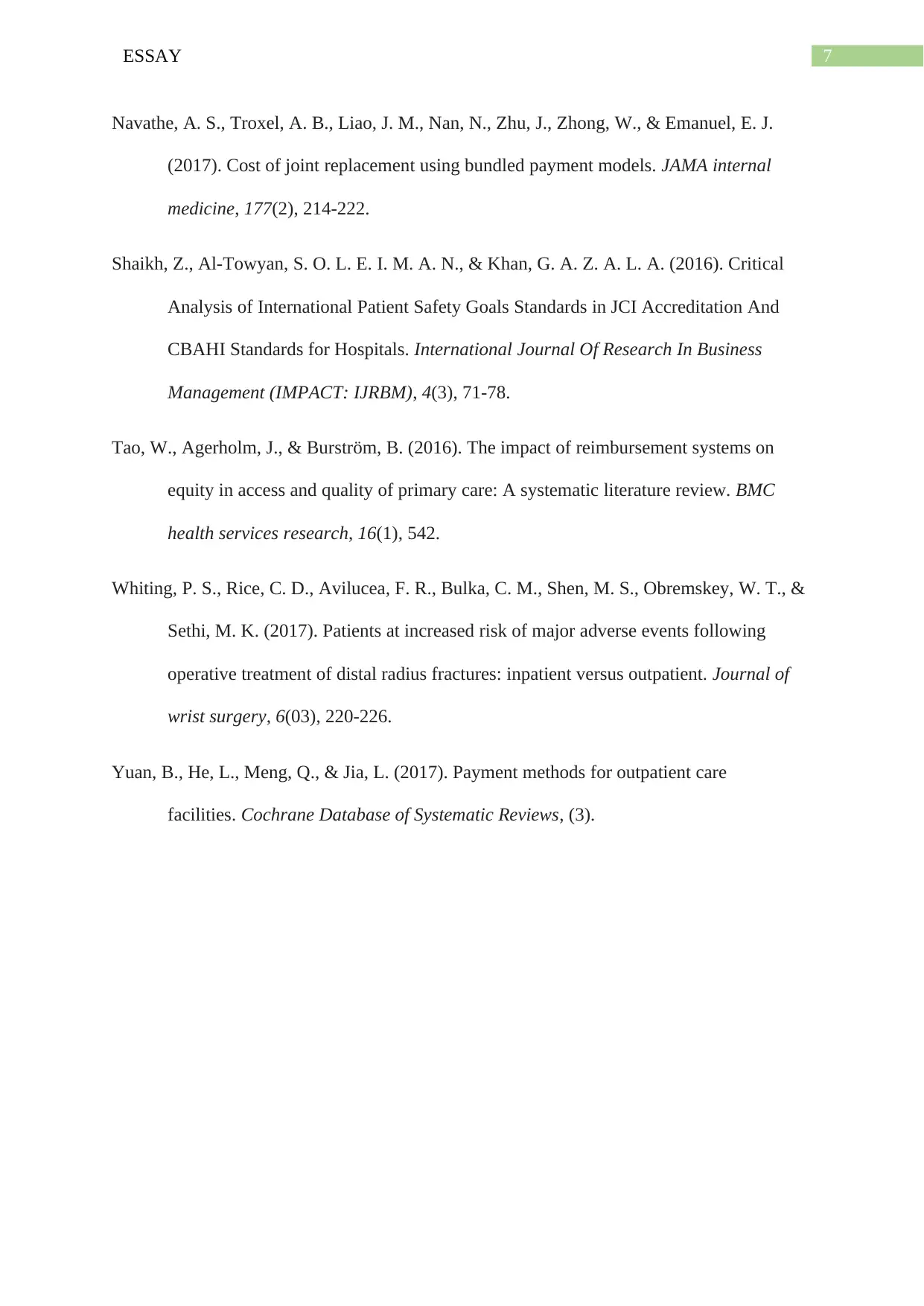
7ESSAY
Navathe, A. S., Troxel, A. B., Liao, J. M., Nan, N., Zhu, J., Zhong, W., & Emanuel, E. J.
(2017). Cost of joint replacement using bundled payment models. JAMA internal
medicine, 177(2), 214-222.
Shaikh, Z., Al-Towyan, S. O. L. E. I. M. A. N., & Khan, G. A. Z. A. L. A. (2016). Critical
Analysis of International Patient Safety Goals Standards in JCI Accreditation And
CBAHI Standards for Hospitals. International Journal Of Research In Business
Management (IMPACT: IJRBM), 4(3), 71-78.
Tao, W., Agerholm, J., & Burström, B. (2016). The impact of reimbursement systems on
equity in access and quality of primary care: A systematic literature review. BMC
health services research, 16(1), 542.
Whiting, P. S., Rice, C. D., Avilucea, F. R., Bulka, C. M., Shen, M. S., Obremskey, W. T., &
Sethi, M. K. (2017). Patients at increased risk of major adverse events following
operative treatment of distal radius fractures: inpatient versus outpatient. Journal of
wrist surgery, 6(03), 220-226.
Yuan, B., He, L., Meng, Q., & Jia, L. (2017). Payment methods for outpatient care
facilities. Cochrane Database of Systematic Reviews, (3).
Navathe, A. S., Troxel, A. B., Liao, J. M., Nan, N., Zhu, J., Zhong, W., & Emanuel, E. J.
(2017). Cost of joint replacement using bundled payment models. JAMA internal
medicine, 177(2), 214-222.
Shaikh, Z., Al-Towyan, S. O. L. E. I. M. A. N., & Khan, G. A. Z. A. L. A. (2016). Critical
Analysis of International Patient Safety Goals Standards in JCI Accreditation And
CBAHI Standards for Hospitals. International Journal Of Research In Business
Management (IMPACT: IJRBM), 4(3), 71-78.
Tao, W., Agerholm, J., & Burström, B. (2016). The impact of reimbursement systems on
equity in access and quality of primary care: A systematic literature review. BMC
health services research, 16(1), 542.
Whiting, P. S., Rice, C. D., Avilucea, F. R., Bulka, C. M., Shen, M. S., Obremskey, W. T., &
Sethi, M. K. (2017). Patients at increased risk of major adverse events following
operative treatment of distal radius fractures: inpatient versus outpatient. Journal of
wrist surgery, 6(03), 220-226.
Yuan, B., He, L., Meng, Q., & Jia, L. (2017). Payment methods for outpatient care
facilities. Cochrane Database of Systematic Reviews, (3).
1 out of 8
Related Documents
Your All-in-One AI-Powered Toolkit for Academic Success.
+13062052269
info@desklib.com
Available 24*7 on WhatsApp / Email
![[object Object]](/_next/static/media/star-bottom.7253800d.svg)
Unlock your academic potential
Copyright © 2020–2025 A2Z Services. All Rights Reserved. Developed and managed by ZUCOL.





